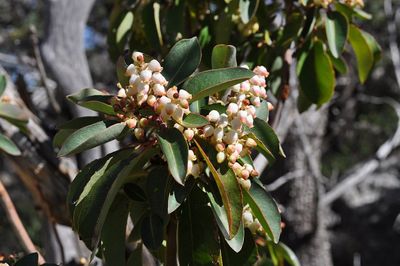Texas Madrone Plant Info
Native to West Texas and New Mexico, the spring blooms of Texas madrone trees (Arbutus xalapensis) are a welcome sight among the scrub pines and bare prairies found there. Multi-stemmed trunks grow to about 30 feet (9 m.). The trees have a vase shape, round crown, and orange-red, berry-like drupes in summer. Branches are strong, growing to withstand the strong winds and resist drooping and breakage. The attractive, white to pink fragrant blossoms grow in clusters as long as 3 inches (7.5 cm.). The most appealing feature, however, is the exfoliating bark. Reddish-brown outer bark peels back to reveal shades of smooth lighter red and orange, most eye-catching with a backdrop of snow. Because of the inner bark, the tree is awarded such common names of naked Indian or lady’s leg. This attractive tree with evergreen foliage can grow in your landscape, even if it is not in a spot with harsh elements. It attracts pollinators but not browsing deer. That said, it should be noted that deer, as with most any trees, may browse on newly planted Madrone. If you have deer around, you should take steps to protect newly planted trees for the first few years. Grow it as a street tree, a shade tree, a specimen, or even in a container.
How to Grow Texas Madrone
Locate the Texas madrone tree in a sunny or partially sunny spot. If using for a shade tree, calculate the potential height and plant accordingly – it is said to grow 12 to 36 inches (30.5-91.5 cm.) per year and the trees may live up to 150 years. Plant in light, loamy, moist, rocky soils that are limestone-based. This tree is known to be somewhat temperamental, as are many specimens with long taproots. Texas madrone care includes making sure the soil is properly loosened deep enough to allow for the growth of the taproot. Should you plant in a container, keep the length of the taproot in mind. Keep the soil moist, but not soggy, when planting this tree. It is somewhat drought tolerant when mature, but gets off to a better start with regular watering. Leaves and bark have astringent uses, and drupes are said to be edible. The wood is often used for tools and handles. The primary use of most homeowners is to help attract birds and pollinators to the landscape.
